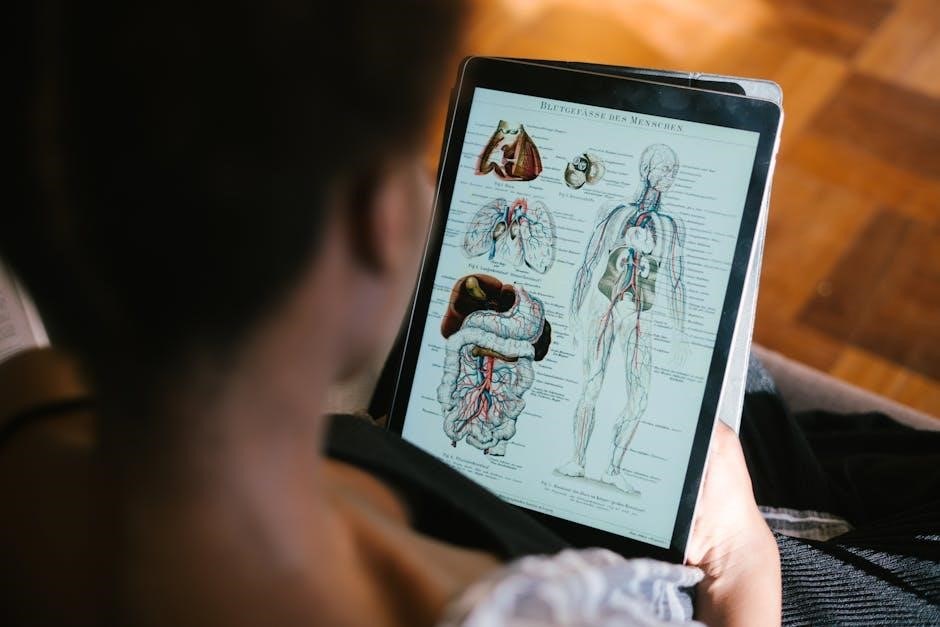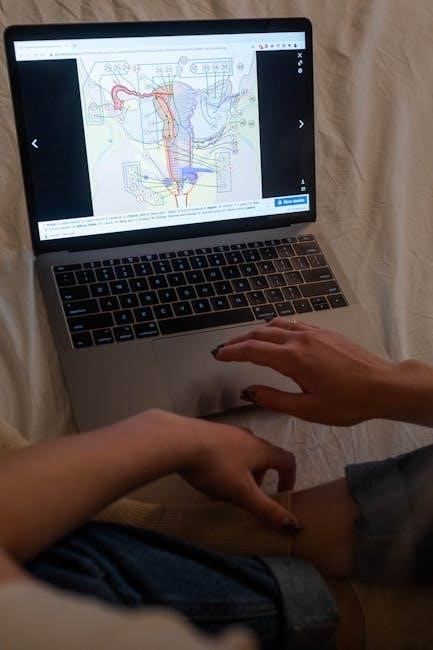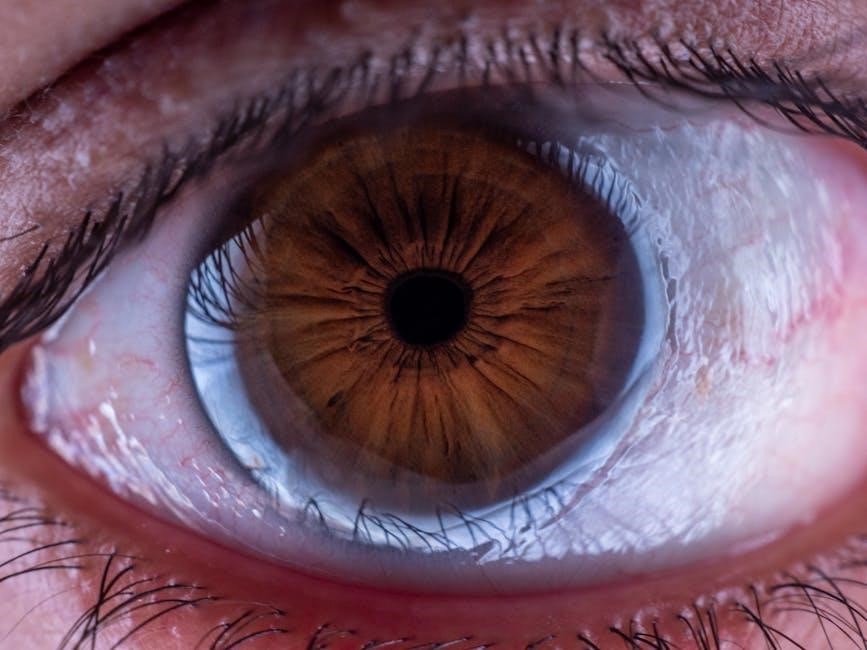Visual analogies simplify complex anatomical concepts by comparing body structures to familiar objects, enhancing understanding and retention. They make learning interactive and engaging for students.
What Are Visual Analogies?
Visual analogies are powerful tools that simplify complex anatomical concepts by comparing body structures or processes to familiar, everyday objects or experiences. They create mental connections, making abstract ideas more tangible and easier to remember. For example, likening the skeleton to a building framework or muscles to elastic bands helps students grasp their roles and functions. These analogies are particularly effective in anatomy education, as they transform intricate systems into relatable imagery, fostering deeper understanding and retention. By bridging the gap between the unfamiliar and the known, visual analogies become invaluable aids in learning and teaching anatomy.
Importance of Visual Learning in Anatomy
Visual learning is crucial in anatomy, as it enables students to grasp complex structures and relationships efficiently. Through illustrations, analogies, and 3D models, visual tools enhance comprehension and retention. They transform abstract concepts into tangible images, making learning interactive and engaging. Studies show that visual aids improve memory recall and spatial understanding, essential for anatomy. By using visual analogies, students can better internalize how systems function and interconnect, fostering a deeper appreciation of the human body’s design. This method not only simplifies learning but also prepares students for practical applications in healthcare and research, making visual learning indispensable in anatomy education.

The Skeletal System
The skeletal system serves as the body’s structural framework, comprising 206 bones that provide support, protection, and facilitate movement. It also produces blood cells, essential for oxygen transport.
Overview of the Skeletal System
The skeletal system is a complex framework of 206 bones that provides structural support, protects vital organs, and facilitates movement. It also produces blood cells in the bone marrow and stores minerals like calcium and phosphorus. The skeleton is dynamic, with bones growing, remodeling, and repairing throughout life. Visual analogies, such as comparing bones to building blocks or a framework, help students visualize how the skeletal system functions as a unified yet adaptable structure. Understanding the skeletal system is foundational for grasping human anatomy, as it forms the basis for muscle attachment and movement. Its stability and flexibility make it a fascinating subject for visual learning techniques.
The Skeleton as a Building Framework
The skeleton serves as the structural foundation of the body, much like a building framework provides stability and shape. Bones act as beams and columns, supporting soft tissues and maintaining posture. The skull and ribcage resemble protective roofing and walls, safeguarding vital organs like the brain and heart. Joints function as hinges and connectors, allowing flexibility and movement. This framework is dynamic, adapting to growth and stress while enabling bodily functions. Visualizing the skeleton as a building structure simplifies its complex role, making it easier to understand how it supports life and movement. This analogy transforms anatomy into a relatable, three-dimensional concept.

The Muscular System
Muscles function like elastic bands, providing movement and stability by contracting and relaxing. They enable the body to perform tasks ranging from fine motor skills to powerful physical actions.
Muscles and Their Functions
Muscles are dynamic tissues that enable movement, maintain posture, and regulate body functions. Skeletal muscles, attached to bones, facilitate voluntary movements like walking or lifting. Smooth muscles manage involuntary actions, such as digestion, while cardiac muscles power the heart’s rhythmic contractions. Muscles contract and relax to produce motion, working in harmony with the nervous system to coordinate complex actions. Their elastic nature, akin to rubber bands, allows for flexibility and strength, essential for tasks ranging from subtle facial expressions to intense physical exertion. Understanding muscle functions is crucial for appreciating how the body moves and maintains overall health.
Muscles as Elastic Bands
Muscles can be likened to elastic bands due to their ability to stretch and return to their original shape. When muscles contract, they shorten, much like pulling an elastic band tight. This tension enables movement and stability. Just as elastic bands store energy when stretched, muscles store potential energy during elongation, releasing it during contraction. This analogy helps visualize how muscles operate under tension, facilitating actions like jumping or throwing. The elastic band comparison simplifies the complex mechanics of muscle physiology, making it easier for learners to grasp these concepts intuitively and remember them effectively in their anatomy studies.

The Nervous System

The nervous system is a complex communication network regulating body functions, enabling thought, movement, and sensory responses. It ensures efficient coordination of the body’s various systems and activities.
Structure and Function of the Nervous System
The nervous system is a intricate network that coordinates and controls body functions. It consists of the central nervous system (brain and spinal cord) and the peripheral nervous system. The brain acts as the control center, processing information and directing responses. Neurons, specialized cells, transmit signals through electrical and chemical impulses. Synapses, small gaps between neurons, facilitate communication. This system enables sensory perception, movement, and cognitive processes. Visual analogies, such as comparing neurons to electrical circuits, help students grasp these complex mechanisms. Understanding the nervous system’s structure and function is essential for appreciating its role in maintaining overall bodily harmony and responsiveness.

The Nervous System as a Communication Network
The nervous system functions like a high-speed communication network, transmitting signals across the body. Neurons act as messengers, sending electrical and chemical signals through synapses. This network enables rapid coordination of movements, sensory responses, and cognitive processes. Visual analogies, such as comparing the nervous system to the internet or a telecommunication grid, help illustrate its role in connecting and controlling bodily functions. Just as data flows through cables and routers, nerve impulses travel through neurons and synapses, ensuring efficient communication. This analogy simplifies the complex processes, making it easier for students to grasp how the nervous system maintains harmony and responsiveness in the body.

The Circulatory System
The circulatory system transports blood throughout the body, supplying oxygen and nutrients while removing waste. Visual analogies, like comparing it to a highway, simplify its complex functions.
Understanding Blood Circulation
Blood circulation is the process by which blood moves through the heart and blood vessels, delivering oxygen and nutrients to tissues while removing waste. Visual analogies, such as comparing blood vessels to a city’s road network, help students grasp this complex process. The heart acts as the central pump, propelling blood through arteries (highways) to smaller capillaries (neighborhood streets), ensuring efficient delivery. This analogy simplifies the circulatory system’s function, making it easier to visualize and understand. Such visual guides enhance learning by breaking down intricate biological mechanisms into relatable concepts, fostering better retention and engagement for anatomy students.
The Circulatory System as a Transportation Highway
The circulatory system can be likened to a vast transportation network, with blood vessels serving as highways. Arteries, like freeways, carry oxygen-rich blood away from the heart to distant tissues. Veins, akin to return routes, bring deoxygenated blood back to the heart. Capillaries act as local roads, allowing nutrients and waste to exchange with cells. Red blood cells are the vehicles, delivering oxygen to tissues while collecting carbon dioxide. This analogy helps students visualize the circulatory system’s efficiency and complexity; By relating it to familiar transportation systems, learners can better comprehend how blood circulates and sustains the body’s functions. This visual approach enhances retention and understanding in anatomy education.

The Respiratory System
The respiratory system, essential for oxygen exchange, can be visually compared to a tree. The trachea is the trunk, branching into bronchi and bronchioles, resembling branches and leaves.
How Breathing Works
Breathing is a vital process where air enters the nostrils, passes through the trachea, and reaches the lungs. The diaphragm contracts, expanding the chest cavity, allowing air to flow into the alveoli. Oxygen diffuses into the bloodstream, while carbon dioxide is expelled during exhalation. Visual analogies, like comparing the respiratory system to a tree, help students understand this process. The trachea acts as the trunk, branching into bronchi and bronchioles, similar to branches and leaves, illustrating how air distributes oxygen efficiently to the body. This analogy simplifies the complex mechanics of breathing, making it easier to visualize and remember.
Lungs as Air Filters and Oxygen Factories
The lungs act as air filters, purifying the air we breathe by removing dust, bacteria, and other particles through tiny hair-like structures called cilia. Once cleaned, oxygen-rich air reaches the alveoli, where gas exchange occurs. Oxygen diffuses into the bloodstream, while carbon dioxide is removed. Visual analogies, such as comparing lungs to air filters or factories, help students grasp their dual role. The lungs filter impurities and “manufacture” oxygen for the body, much like a factory processes raw materials into essential products. This analogy highlights the lungs’ critical function in maintaining life and overall health, making complex processes more relatable and easier to understand.

The Digestive System
The digestive system is a complex process that breaks down food into nutrients for energy and growth, involving organs like the mouth, stomach, and intestines working together seamlessly.
Process of Digestion
Digestion begins in the mouth with chewing and mixing food with saliva, breaking it down mechanically and chemically. The esophagus transports food to the stomach, where gastric juices further decompose it into chyme. The small intestine absorbs nutrients via finger-like villi, aided by pancreatic enzymes and bile from the liver. The large intestine absorbs water, forming solid waste. This process efficiently extracts nutrients for energy and growth, relying on coordinated organs and enzymes to transform food into usable resources, much like a factory processing raw materials into finished products.
The Digestive System as a Nutrient Factory
The digestive system functions like a nutrient factory, processing food into essential resources. The mouth acts as the factory’s input zone, breaking down food mechanically and chemically. The esophagus serves as a conveyor belt, transporting the mixture to the stomach, where digestive juices further refine it. The small intestine is the extraction unit, absorbing nutrients into the bloodstream. The bloodstream acts as the delivery system, transporting nutrients to cells. The large intestine handles waste management, ensuring only usable materials are retained. This factory-like process efficiently transforms food into energy, maintaining the body’s vitality and functionality, much like an industrial plant producing vital goods.

Creating Effective Visual Analogies
Effective visual analogies simplify complex anatomical concepts by connecting them to relatable objects. They enhance learning by making abstract ideas more concrete and memorable through vivid comparisons.
Designing Clear and Memorable Analogies
Designing clear and memorable analogies involves aligning anatomical structures with familiar objects. For instance, comparing the skeletal system to a building framework simplifies its role as structural support. Mnemonics and illustrations further enhance retention, making complex concepts more accessible. Visual guides, such as diagrams and 3D models, complement these analogies, providing a holistic understanding. This approach not only aids in immediate comprehension but also fosters long-term retention, making anatomy education more engaging and effective for students of all learning styles.
Using Mnemonics and Illustrations
Mnemonics and illustrations are powerful tools in anatomy education, enhancing visual analogies. Mnemonics create mental associations, aiding memory retention, while illustrations provide clear, visual representations. Together, they simplify complex structures, making learning engaging and effective. For example, diagrams of the circulatory system as a highway network clarify blood flow. This combination of techniques ensures students grasp and retain anatomical details efficiently, fostering a deeper understanding of human anatomy through interactive and memorable learning experiences.
Visual analogies in anatomy education have proven to enhance learning. Future trends may include interactive 3D models and augmented reality, further engaging students and improving understanding.
Impact of Visual Guides on Anatomy Education
Visual guides, such as analogy-based tools, significantly enhance anatomy education by making complex structures more relatable. They engage students through interactive and memorable representations, improving retention. These resources break down intricate systems into understandable components, fostering deeper comprehension. The use of visual analogies and mnemonic devices has been shown to boost academic performance and reduce study time. By providing clear, relatable comparisons, visual guides empower learners to grasp abstract concepts more effectively. This approach not only simplifies learning but also encourages active participation, making anatomy education more accessible and enjoyable for students of all levels.
Future Trends in Visual Anatomy Resources
Future visual anatomy resources will likely integrate advanced technologies like AI and machine learning to create dynamic, interactive models. Virtual and augmented reality will immersive learning, allowing students to explore anatomy in 3D. Personalized learning tools will adapt to individual needs, enhancing engagement. Gamification elements, such as interactive quizzes and challenges, will make studying anatomy more enjoyable. Additionally, real-time assessments and feedback systems will help students track their progress; These innovations promise to revolutionize anatomy education, making it more accessible, engaging, and effective for future generations of learners.
